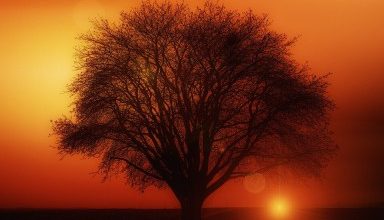The Law of Life by Jack London charts the final hours in the life of Koskoosh, the erstwhile leader of the tribe but an old man now. For practical reasons, he is left behind as the tribe must move camp to somewhere where there are caribou to be had. The story is a poignant portrayal of Koskoosh’s earnest attempt to cling to life even as he accepts the fact that it is in fact the law of nature that the old perishes as the new marches on.
‘The Law of Life’ was first published in the sixteenth volume of McClure’s Magazine in 1901. In the next year, it was published in The Children of Frost, a collection of stories by London.
The Law of Life SUMMARY
Koskoosh is the former leader of his tribe. His son is the current leader and under his leadership, the tribe is making preparations in order to shift its camp elsewhere since food has become sparse in the winter in this region. Koskoosh, however, is too old and infirmed to undertake the journey with the rest of the tribesmen and so he will be left behind. Koskoosh knows very well that he is about to die very soon, in the helpless solitude and cold.
Koskoosh watches the members of the tribe prepare for the journey he will not be a part of. He tries to hear and see everything intently because he knows this is the last time he will see his kinsmen. He hears a crying child and thinks that the child is perpetually sick and will die soon.
At last, the tribe leaves. Koskoosh remembers how old members of other tribes too were similarly left behind when the tribe decided to move camp. However, he is happy that his son at least stays back for a while to talk to him.
When his son leaves him too, Koskoosh checks the sticks available with him because the handful of sticks is now ‘the measure of his life’. But Koskoosh also realizes that no precaution would matter in the end because he, an old man incapable of keeping up with the young ones, is about to die and this is the law of life. He even thinks this is a just law. He knows very well that nature does not at all care about human beings; the propagation of the group is what men must ensure, even if it comes at the cost of individuals. Koskoosh ponders about how even other animals like the rabbit or the bear must eventually die when it is their time, and how he had to leave his own father behind once upon a time. He keeps revisiting memories as he remembers a particularly vicious famine that killed his mother and many other people. Interestingly, he can also remember ‘times of plenty’ when men had food in excess.
Koskoosh now remembers how he and his friend Zing-ha once tracked down the traces of a pack of wolves chasing down a moose. The tracks on the snow gave them the true picture of how the events unfolded: the wolves kept up their relentless attack on the moose but the latter did not give up fighting its enemies till its last breath. Even when death seemed dangerously near, the moose fought back. Koskoosh now momentarily basks in the glory of his youth when he was the leader of his tribe and the source of sheer terror for his enemies.
As Koskoosh keeps reminiscing about his past, he suddenly becomes aware of the amount of wood left with him for the fire. As he tries to keep the fire going, Koskoosh grudgingly thinks that Sit-cum-ha should have picked more wood for her grandfather. He even starts thinking wishfully if there is any chance of his son’s returning to take him along. However, at this point, he feels the presence of other animals near him. They are wolves. He tries to shoo some of them away using the burning sticks. The thought of the moose occurs to him now. But the fire eventually dies and the wolves draw closer to him. Koskoosh finally surrenders to the fate that is the law of life.
‘The Law of Life’ ANALYSIS
Jack London’s works prominently highlight the tradition of literary naturalism. Mainly formulated by French novelist Emile Zola, literary naturalism seeks to show how man’s surrounding circumstances, especially nature, shape man and his way of living. Heavily influenced by Darwin’s theory of evolution, naturalism is an offshoot of realism that, through determinism and pessimism, shows how natural laws are absolute how man cannot break free from their chains, and how only the fittest survives in a conflict. Works written as part of this tradition often use an objective narration to bring out this notion. Many of London’s stories dwell on these themes.
THEMES
The short story features a series of battles between conflicting notions. There is a dichotomy between the group and the individual, for instance, and the individual has to back away when their respective interests collide, as they do in ‘The Law of Life’. The camp must move elsewhere in order to ensure the survival of the group. But this itself is very much against the personal interests of Koskoosh who will inevitably die after the group leaves him alone. The very first passage of the story clearly states the battle between the two agents:
‘Camp must be broken. The long trail waited while the short day refused to linger. Life called her, and the duties of life, not death. And he [Koskoosh] was very close to death now.’
Koskoosh is now a liability to the group, no matter his former glories. That the group must leave him behind is only practical; the harshness of nature forces its inhabitants here to take up the Darwinian dictum of ‘the survival of the fittest’ if they are to survive. Even Koskoosh knows that to ‘continue the race was the task of life; its law was death’. However, Koskoosh is but a man, and man wants to cling to life no matter what. This is where another battle of conflicting ideas is seen: the acknowledgment that the ‘law of life’ is death while yearning to defer the onset of death nevertheless. In other words, this is a tussle between a docile acceptance of the inevitability of death and the spirited resistance against it nonetheless.
Indeed, Koskoosh is seen oscillating between these two states for most of the story, highlighting another major theme of the story: how man strives to live on and on even when he knows that death is unavoidable. Naturalism paints a deterministic view of the universe but man, by virtue of his willpower, wants to exert his free will. However, in keeping with naturalism, the battle between man’s willpower and the laws of nature is won by the laws of nature, of course.
This story is also a ‘man versus nature’ story but this theme takes on two different levels in the story. ‘Nature’ of course is the natural world that Koskoosh and indeed his entire tribe are fighting against in order to survive.‘Nature’ also is the natural process of aging, a process that affects Koskoosh personally in the story, reducing him to the status of a burden who would potentially slow down the journey of the tribe and hence, is best left behind to meet his end.
The overarching thematic battle of the story, as it were, happens between life and death, symbolized by a host of motifs in the story. The dry nature is a harbinger of death, while the fire is the possibility of life; similarly, the pack of wolves is the messenger of death, while the heroic last fight of the moose, and the last attempts of Koskoosh too, are indicators of the preciousness of life; the motion seen in the other members is the yearning to ensure sustenance of life, while the stagnation that Koskoosh is doomed to is the prequel to death. Eventually, death, the law of life, wins.
The indifference of nature towards human beings is clearly portrayed in the story. There is the description of a strong famine (‘not one in ten of the tribe lived to meet the sun when it came back in the spring. That was a famine!’) as well as the times of plenty; nature is a capricious entity with no consideration for humans. And yet, within this, life moves on, as it must. The cycle of life carried on even when there was famine, and it must carry on now when it is extremely cold and food is scarce. Death is the law of life, surely, but life finds a way to march on until that fate is met.
Memory is interestingly used in the story to show the cycle of life and death, and the rise and fall of man’s fortune. As Koskoosh thinks of his past, he realizes that nothing that is happening to him now is new, and it will happen to many others in the future too.
CHARACTERS IN THE STORY
Koskoosh: former leader of the tribe but an old man now who cannot join the others in their journey. He is left behind. At first, he is ready to accept his fate but when the others actually leave him alone, he is desperate to delay his impending death. At last, he has to give up when he is surrounded by the wolves.
Koskoosh’s son: the current leader of the tribe. He has no choice but to put the tribe in front of his filial considerations and so he leaves his father behind. However, he stays back for a while to talk to his father and this makes Koskoosh happy.
LITERARY DEVICES
Verbal irony and simile are seen in Koskoosh’s reply to his son when the latter asks him before departing how he is at the moment:
It is well. I am as a last year’s leaf, clinging lightly to the stem. The first breath blows, and I fall. My voice is become like an old woman’s. My eyes no longer show me the way of my feet, and my feet are heavy, and I am tired. It is well.
To show how nature and death have the ultimate agency in the story, entities of nature, and death are often personified in the story. The following passage shows this:
Then his hand crept out in haste to the wood. It alone stood between him and the eternity that yawned in upon him. At last, the measure of his life was a handful of fagots. One by one they would go to feed the fire, and just so, step by step, death would creep upon him. When the last stick had surrendered its heat, the frost would begin to gather strength.
Euphemism is used to indicate death when Koskoosh muses about how even the rabbits and bears must die too when they are old and cannot defend themselves against their enemies.
Metonymy is used in the story when the phrase ‘forms of gray’ is used in place of directly mentioning wolves. Similarly, synecdoche is seen when simply a ‘cold nose’ is made to stand in for the body of the wolf.
ABOUT THE AUTHOR
Jack London was an American novelist and journalist. He was born on January 12, 1876, and died on November 22, 1916. He is one of the leading figures of the tradition of literary naturalism, and his short story ‘To Build a Fire’ remains one of the best texts from this tradition.

